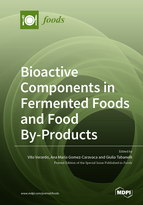Health and Bioactive Compounds of Fermented Foods and By-Products
A special issue of Fermentation (ISSN 2311-5637). This special issue belongs to the section "Fermentation for Food and Beverages".
Deadline for manuscript submissions: closed (31 August 2023) | Viewed by 15517
Special Issue Editors
2. Laboratory of Advanced Analysis in Biochemistry and Molecular Biology (LAABBM), Department of Biochemistry, UFRJ, Rio de Janeiro 21941-909, RJ, Brazil
Interests: food science and food safety; goat; meat quality
Special Issues, Collections and Topics in MDPI journals
2. Research Support Group on Nanomaterials, Polymers, and Interaction with Biosystems (BioNano), Chemistry Institute, UFRJ, Rio de Janeiro 21941-901, RJ, Brazil
Interests: food science; polymers; biopolymers; recyclability; biodegradable polymers; biopesticides; agriculture
Special Issues, Collections and Topics in MDPI journals
Special Issue Information
Dear Colleagues,
Microorganisms—mainly lactic acid bacteria, and yeasts—can produce large contents of secondary metabolites with several health benefits and preservative properties such as antimicrobial activities. At the same time, some microorganisms can increase the levels of vitamins, antioxidant compounds, peptides, exopolysaccharides, organic acids, and other bioactive molecules. Fermented foods contain living organisms that contribute to the modulation of gut microbiota, physiology, and cellular redox homeostasis, meanwhile enriching the host diet with new bioactive compounds. Thus, recent advances have also reported anticancer and immunomodulatory potential in a preclinical stage of an investigation. Moreover, other recent advances in fermentation are focused on food by-products, especially as a potential source of bioactive compounds and food-derived biopolymers that, after fermentation, could be combined with nanotechnology and used as ingredients and additives for nutraceutical and functional foods. Understanding the health benefits of bioactive molecules of food fermentation and their by-products is a growing field of research in food science, preventive nutrition, and the treatment of diseases. Thus, this Special Issue of Fermentation, entitled “Health and Bioactive Compounds of Fermented Foods and By-Products”, welcomes high-quality original papers and review articles evaluating the effect of the bioactive compounds of fermented foods and their by-products to improve or maintain human health.
Dr. Carlos A. Conte-Junior
Dr. Anna Paula Azevedo De Carvalho
Guest Editors
Manuscript Submission Information
Manuscripts should be submitted online at www.mdpi.com by registering and logging in to this website. Once you are registered, click here to go to the submission form. Manuscripts can be submitted until the deadline. All submissions that pass pre-check are peer-reviewed. Accepted papers will be published continuously in the journal (as soon as accepted) and will be listed together on the special issue website. Research articles, review articles as well as short communications are invited. For planned papers, a title and short abstract (about 100 words) can be sent to the Editorial Office for announcement on this website.
Submitted manuscripts should not have been published previously, nor be under consideration for publication elsewhere (except conference proceedings papers). All manuscripts are thoroughly refereed through a single-blind peer-review process. A guide for authors and other relevant information for submission of manuscripts is available on the Instructions for Authors page. Fermentation is an international peer-reviewed open access monthly journal published by MDPI.
Please visit the Instructions for Authors page before submitting a manuscript. The Article Processing Charge (APC) for publication in this open access journal is 2600 CHF (Swiss Francs). Submitted papers should be well formatted and use good English. Authors may use MDPI's English editing service prior to publication or during author revisions.
Keywords
- value-added by-products
- polyphenols
- bioactive compounds
- antimicrobial activity
- antioxidants
- health benefits of fermented foods
- nutraceuticals
- nanomedicine
- fermentation
- biopolymers







